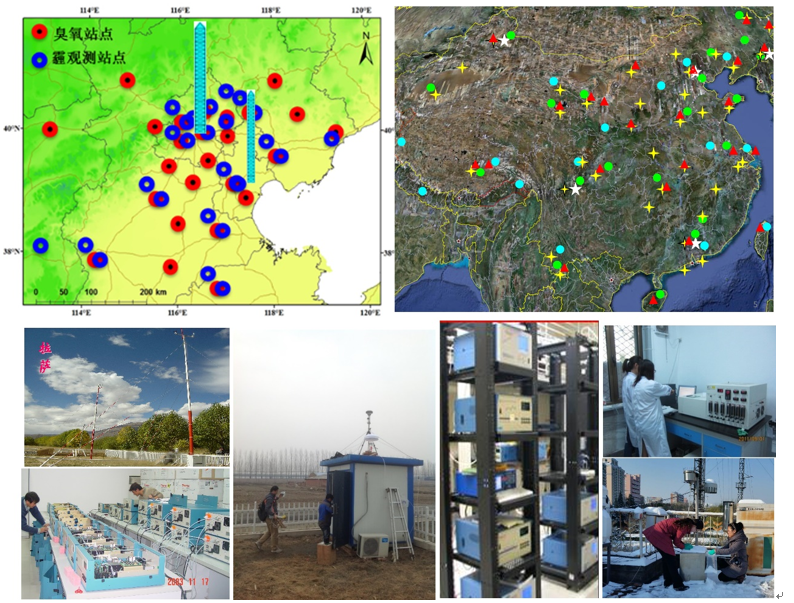Sub-Center of Atmospheric Sciences, Chinese Ecosystem Research Network
Main research fields
Mechanisms and prediction of urban and regional air pollution and their effects on the atmospheric environment;
Evaluation of trace gases and aerosol concentrations, the mass exchange between the biosphere and atmosphere, and their effects on the environment and climate.
Main achievements
Focusing on air pollution issues, Sub-Center of Atmospheric Sciences, Chinese Ecosystem Research Network (SCAS-CERN) first focused on technical innovation in the fields of atmospheric chemistry and environment, driving continuous development and breakthroughs with respect to basic theory and numerical modeling. We established a national and regional atmospheric chemistry and environment observation platform and conducted large-scale, multi-level and multi-scale observation campaigns. These pioneering, prospective and comprehensive research activities have provided important scientific and technological support for national air pollution control, climate change assessment, and ecological progress. The main achievements are as follows:
1. Multi-layered and multi-scale atmospheric chemistry and environment observation network
Relying on the Chinese Ecosystem Research Network (CERN), national-scale meteorological radiation observations were launched at 45 radiation stations in 1990. The observations adopt independently designed specifications and new standard technology systems and focus on nationally networked measurements of UV and photosynthetically active radiation and soil heat flux, which are closely related to ecological and environmental processes, all of which showcase CERN’s main duties—i. e., observation, research, and demonstration. The innovative technological method used at CERN won the second prize at the National Science and Technology Progress Awards in 2011. Based on the composite observations of CERN, the spatial and temporal variation of UV and photosynthetically active radiation in mainland China was firstly given. In addition, the Chinese Sun Hazemeter Network (CSHNET) was established in 2004, based on CERN ecological stations. Then, in combination with CSHNET and CERN’s meteorological radiation network, CSHNET gradually formed a comprehensive observation network of aerosol physical, chemical and optical properties (referred to as CARE-China). The CARE-China network provides a scientific basis for studying the effects of aerosol on climate, applicable to national policymaking for the control of air pollution.
2. Formation mechanisms of air pollution in the North China Plain region
Relying on the technologies of ground-based observation, tower-based observation, and satellite remote sensing, researchers have gradually built a regional integrated three-dimensional atmospheric chemistry and environment observation network since 2007 in the North China Plain region. This observation network took the lead in filling the gaps created by the problem of coordinating observations across administrative regions, as well as applying different technologies and considering different factors in one experimental design at the national or regional scale. With the observation results, a new view in which heavy haze pollution in Beijing starts from surrounding transport and strengthens local emission sources, was put forward. In addition, the research team has also established the Regional Atmospheric Deposition Observation Network in the North China Plain (or READ-NCP), running since 2007. Subsequently, long-term observations have been carried out to track the temporal variations, spatial distribution and chemical components of deposited materials of carbon, nitrogen, sulfur and heavy metals.
3. Chemical mechanism of "NOx-centered theory" and reactive nitrogen emissions reduction
At the beginning of 2013, in response to the increasing frequency of haze pollution events in eastern China, our research group proposed the "NOx-centered theory" to explain the key chemical processes of heavy haze pollution formation—that is, high concentrations of NOx promote the synergistic transformation of SO2 to particulate-matter sulfate. The "NOx-centered theory" was further confirmed by continuous field observations and smoke chamber experiments after collaboration with research teams at home and abroad. Finally, a parameterized scheme of the chemical mechanism was coupled into the WRF-CHEM atmospheric chemistry model, which reproduced the formation process of heavy haze pollution in North China. Therefore, "NOx-centered theory" has become a recognized scientific theory supporting efforts with respect to regional heavy haze pollution prevention and control.
Staff
The Sub-Center of Atmospheric Sciences (SCAS) now has a total of 21 staff, including 6 professors and 7 associate professors. Moreover, there are more than 20 graduates in SCAS.
Director: HU Bo

